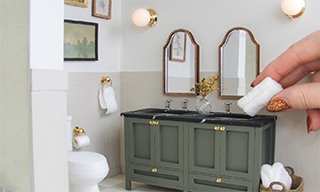
Prime with oil-based primer, then paint over it with flat acrylic paint. Apply one coat of paint with a 2" wide regular-sized paintbrush and let dry completely. We used Kilz® Original™ Oil Based Primer, then Kilz Casual Colors Interior Flat Acrylic Paint (color: Cactus) in our example.
Tint #2076 Mortar Mix with acrylic paint. Mix with a stirring stick and let set for about five minutes.
In large areas, thickly apply the stucco/paint mixture with the regular brush, and in smaller areas with a 1" wide craft brush. Then, create the texture with a 2" diameter stiff stencil stippling brush. Pound the stencil brush at right angles on the surfaces of the house until the faux stucco coverage is even and the texture in scale. The stippling brush/stucco technique provides a beautifully scaled texture.
The final secret for a realistic stucco finish is to use a glaze or watered down darker paint. Randomly dab it over the walls and lift off any excess with a wad of paper towel. Apply more heavily at the bottom of the walls where imaginary rain splashes up and in streaks down from any place where rainwater might gather and run. If you look at a stucco house that is only one rainstorm old, you will see that its color is not uniform. The older the house, the more it becomes discolored by weather, and that's what you want to recreate for realistic-looking miniature houses.



